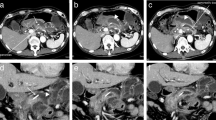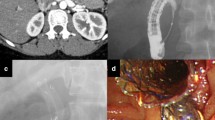Abstract
A 69-year-old man was referred to our hospital with obstructive jaundice. A tumor with poor contrast enhancement was found in the pancreatic head, but there was no evidence of pancreatic atrophy, irregular stenosis, or dilation of the main pancreatic duct. He was diagnosed with borderline resectable pancreatic cancer with distal malignant biliary obstruction. After plastic stent placement, serum bilirubin levels improved, and chemotherapy was started. However, he developed cholangitis; thus, the plastic stent was replaced with a covered self-expandable metallic stent. He subsequently developed a delayed pancreatic fistula due to main pancreatic duct disruption. An endoscopic nasopancreatic duct drainage tube was placed to bridge the main pancreatic duct disruption after removing the covered self-expandable metallic stent. In addition, endoscopic ultrasound-guided transmural drainage was performed for the infected fluid collection caused by the pancreatic fistula, and the clinical symptoms quickly improved. This case presents the possibility of a delayed pancreatic fistula due to self-expandable metallic stent deployment. The need for considering such delayed complications when placing self-expanding metallic stents is highlighted.






Similar content being viewed by others
References
Davids PH, Groen AK, Rauws EA, et al. Randomised trial of self-expanding metal stents versus polyethylene stents for distal malignant biliary obstruction. Lancet. 1992;340:1488–92.
Isayama H, Yasuda I, Ryozawa S, et al. Results of a Japanese multicenter, randomized trial of endoscopic stenting for non-resectable pancreatic head cancer (JM-test): covered wallstent versus double layer stent. Dig Endosc. 2011;23:310–5.
Kitano M, Yamashita Y, Tanaka K, et al. Covered self-expandable metal stents with an anti-migration system improve patency duration without increased complications compared with uncovered stents for distal biliary obstruction caused by pancreatic carcinoma: a randomized multicenter trial. Am J Gastroenterol. 2013;108:1713–22.
Tringali A, Hassan C, Rota M, et al. Covered vs. uncovered self-expandable metal stents for malignant distal biliary strictures: a systematic review and meta-analysis. Endoscopy. 2018;50:631–41.
Shiomi H, Nakano R, Ota S. Covered self-expandable metal stents for distal biliary obstruction from pancreatic carcinoma: what type of stent is preferred? Clin Endosc. 2022;55:369–71.
Tol JA, van Hooft JE, Timmer R, et al. Metal or plastic stents for preoperative biliary drainage in resectable pancreatic cancer. Gut. 2016;65:1981–7.
Crippa S, Cirocchi R, Partelli S, et al. Systematic review and meta-analysis of metal versus plastic stents for preoperative biliary drainage in resectable periampullary or pancreatic head tumors. Eur J Surg Oncol. 2016;42:1278–85.
Tsuboi T, Sasaki T, Serikawa M, et al. Preoperative biliary drainage in cases of borderline resectable pancreatic cancer treated with neoadjuvant chemotherapy and surgery. Gastroenterol Res Pract. 2016;2016:7968201.
Nakai Y, Isayama H, Kawakubo K, et al. Metallic stent with high axial force as a risk factor for cholecystitis in distal malignant biliary obstruction. J Gastroenterol Hepatol. 2014;29:1557–62.
Coté GA, Kumar N, Ansstas M, et al. Risk of post-ERCP pancreatitis with placement of self-expandable metallic stents. Gastrointest Endosc. 2010;72:748–54.
Cotton PB, Garrow DA, Gallagher J, et al. Risk factors for complications after ERCP: a multivariate analysis of 11,497 procedures over 12 years. Gastrointest Endosc. 2009;70:80–8.
Isayama H, Nakai Y, Toyokawa Y, et al. Measurement of radial and axial forces of biliary self-expandable metallic stents. Gastrointest Endosc. 2009;70:37–44.
Kawakubo K, Isayama H, Nakai Y, et al. Risk factors for pancreatitis following transpapillary self-expandable metal stent placement. Surg Endosc. 2012;26:771–6.
Tarnasky PR, Cunningham JT, Hawes RH, et al. Transpapillary stenting of proximal biliary strictures: does biliary sphincterotomy reduce the risk of postprocedure pancreatitis? Gastrointest Endosc. 1997;45:6–51.
Shimizu S, Naitoh I, Nakazawa T, et al. Predictive factors for pancreatitis and cholecystitis in endoscopic covered metal stenting for distal malignant biliary obstruction. J Gastroenterol Hepatol. 2013;28:68–72.
Nakai Y, Isayama H, Komatsu Y, et al. Efficacy and safety of the covered wall stent in patients with distal malignant biliary obstruction. Gastrointest Endosc. 2005;62:742–8.
Xia MX, Zhou YF, Zhang M, et al. Influence of fully covered metal stenting on the risk of post-endoscopic retrograde cholangiopancreatography pancreatitis: a large multicenter study. J Gastroenterol Hepatol. 2020;35:2256–63.
Maruyama H, Shiba M, Ishikawa-Kakiya Y, et al. Positive correlation between pancreatic volume and post-endoscopic retrograde cholangiopancreatography pancreatitis. J Gastroenterol Hepatol. 2020;35:769–76.
Takeda T, Sasaki T, Mie T, et al. Novel risk factors for recurrent biliary obstruction and pancreatitis after metallic stent placement in pancreatic cancer. Endosc Int Open. 2020;8:E1603–10.
Tyberg A, Karia K, Gabr M, et al. Management of pancreatic fluid collections: a comprehensive review of the literature. World J Gastroenterol. 2016;22:2256–70.
Jang JW, Kim MH, Oh D, et al. Factors and outcomes associated with pancreatic duct disruption in patients with acute necrotizing pancreatitis. Pancreatology. 2016;16:958–65.
Trevino JM, Tamhane A, Varadarajulu S. Successful stenting in ductal disruption favorably impacts treatment outcomes in patients undergoing transmural drainage of peripancreatic fluid collections. J Gastroenterol Hepatol. 2010;25:526–31.
Singh P, Das A, Isenberg G, et al. Does prophylactic pancreatic stent placement reduce the risk of post-ERCP acute pancreatitis? A meta-analysis of controlled trials. Gastrointest Endosc. 2004;60:544–50.
Mazaki T, Masuda H, Takayama T. Prophylactic pancreatic stent placement and post-ERCP pancreatitis: a systematic review and meta-analysis. Endoscopy. 2010;42:842–53.
Sofuni A, Maguchi H, Mukai T, et al. Endoscopic pancreatic duct stents reduce the incidence of post-endoscopic retrograde cholangiopancreatography pancreatitis in high-risk patients. Clin Gastroenterol Hepatol. 2011;9(851–8): e110.
Simmons DT, Petersen BT, Gostout CJ, et al. Risk of pancreatitis following endoscopically placed large-bore plastic biliary stents with and without biliary sphincterotomy for management of postoperative bile leaks. Surg Endosc. 2008;22:1459–63.
Banerjee N, Hilden K, Baron TH, et al. Endoscopic biliary sphincterotomy is not required for transpapillary SEMS placement for biliary obstruction. Dig Dis Sci. 2011;56:591–5.
Hayashi T, Kawakami H, Osanai M, et al. No benefit of endoscopic sphincterotomy before biliary placement of self-expandable metal stents for unresectable pancreatic cancer. Clin Gastroenterol Hepatol. 2015;13:1151-8.e2.
Sofi AA, Nawras A, Alaradi OH, et al. Does endoscopic sphincterotomy reduce the risk of post-endoscopic retrograde cholangiopancreatography pancreatitis after biliary stenting? A systematic review and meta-analysis. Dig Endosc. 2016;28:394–404.
Freeman ML, Nelson DB, Sherman S, et al. Complications of endoscopic biliary sphincterotomy. N Engl J Med. 1996;335:909–18.
Kato S, Kuwatani M, Onodera M, et al. Risk of pancreatitis following biliary stenting with/without endoscopic sphincterotomy: a randomized controlled trial. Clin Gastroenterol Hepatol. 2022;20:1394-1403.e1.
Kataoka F, Inoue D, Watanabe M, et al. Efficacy of 6-mm diameter fully covered self-expandable metallic stents in preoperative biliary drainage for pancreatic ductal adenocarcinoma. DEN open. 2022;2: e55.
Kawashima H, Hashimoto S, Ohno E, et al. Comparison of 8- and 10-mm diameter fully covered self-expandable metal stents: a multicenter prospective study in patients with distal malignant biliary obstruction. Dig Endosc. 2019;31:439–47.
Author information
Authors and Affiliations
Corresponding author
Ethics declarations
Conflict of interest
All the authors who contributed to this study declare no conflict of interests.
Human rights
All the procedures followed in this study have been performed in accordance with the ethical standards laid down in the 1964 Declaration of Helsinki and its later amendments.
Informed consent
Informed consent was obtained from the patient prior to his inclusion in the study.
Additional information
Publisher's Note
Springer Nature remains neutral with regard to jurisdictional claims in published maps and institutional affiliations.
Rights and permissions
Springer Nature or its licensor (e.g. a society or other partner) holds exclusive rights to this article under a publishing agreement with the author(s) or other rightsholder(s); author self-archiving of the accepted manuscript version of this article is solely governed by the terms of such publishing agreement and applicable law.
About this article
Cite this article
Ota, S., Shiomi, H., Nakano, R. et al. A case of delayed pancreatic fistula after covered self-expandable metallic stent deployment for pancreatic head cancer. Clin J Gastroenterol 16, 303–309 (2023). https://doi.org/10.1007/s12328-023-01759-0
Received:
Accepted:
Published:
Issue Date:
DOI: https://doi.org/10.1007/s12328-023-01759-0




